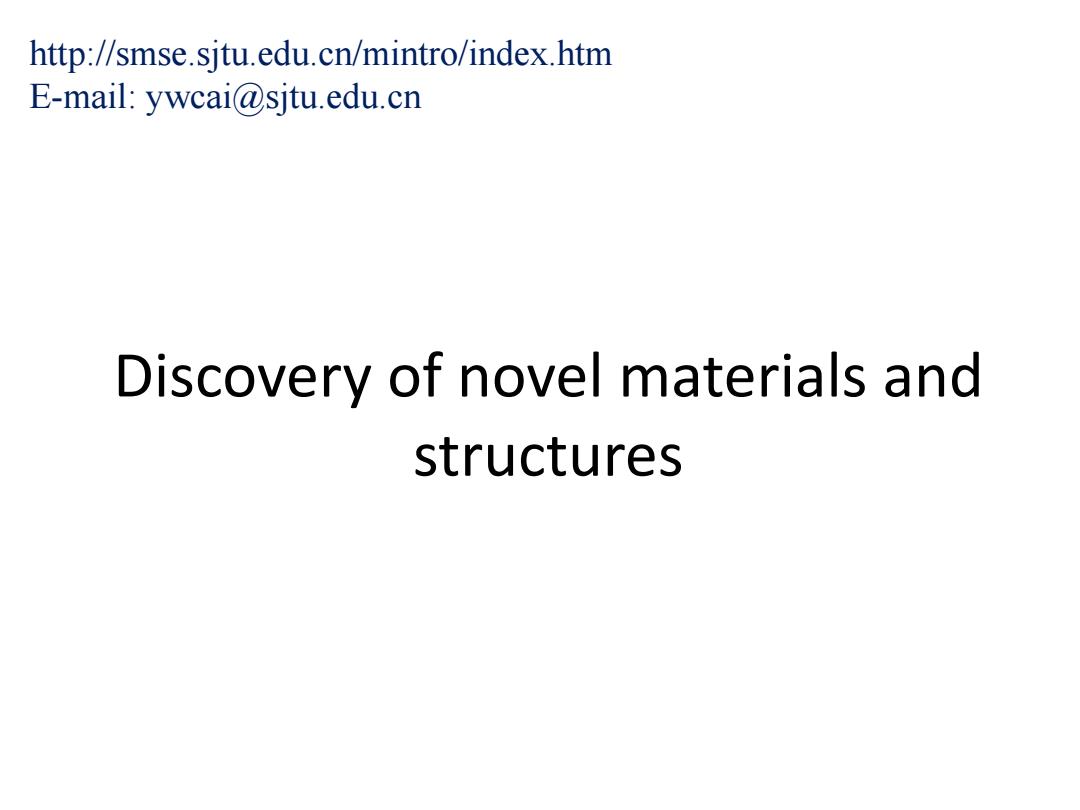
http://smse.sjtu.edu.cn/mintro/index.htm E-mail:ywcai@sjtu.edu.cn Discovery of novel materials and structures
Discovery of novel materials and structures http://smse.sjtu.edu.cn/mintro/index.htm E-mail: ywcai@sjtu.edu.cn

Hook and Loop fabric fasteners Velcro (hook side)
Hook and Loop fabric fasteners Velcro (hook side)
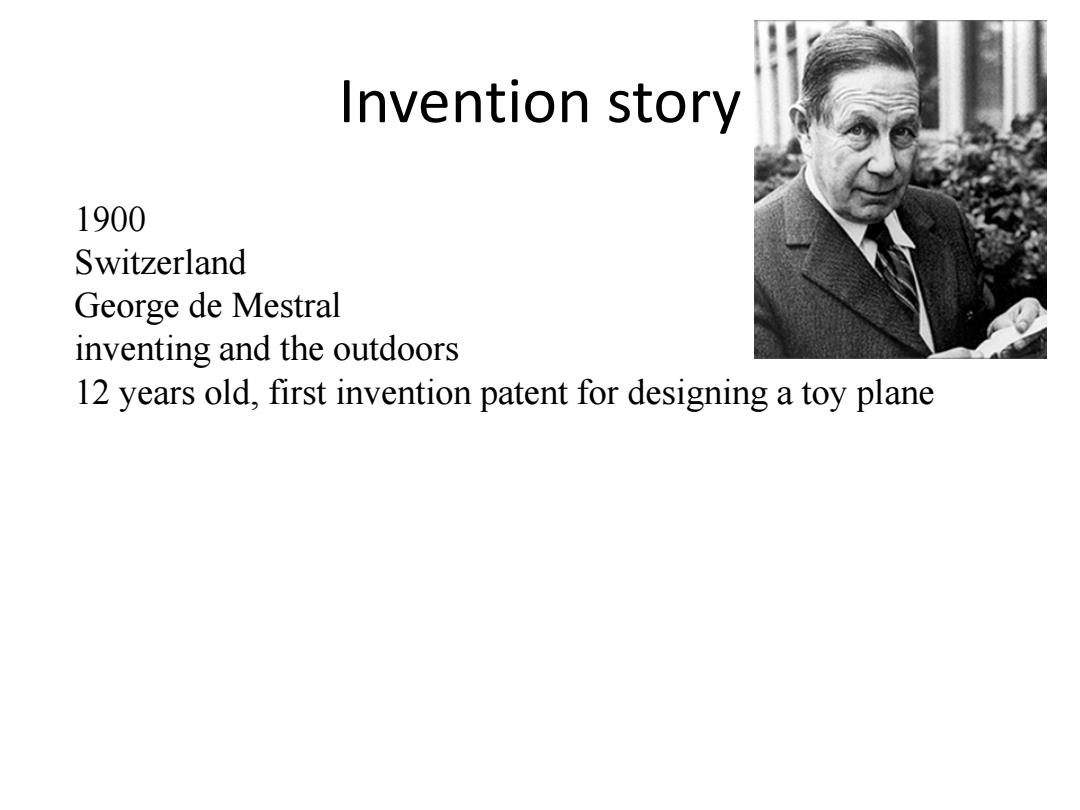
Invention story 1900 Switzerland George de Mestral inventing and the outdoors 12 years old,first invention patent for designing a toy plane
Invention story 1900 Switzerland George de Mestral inventing and the outdoors 12 years old, first invention patent for designing a toy plane
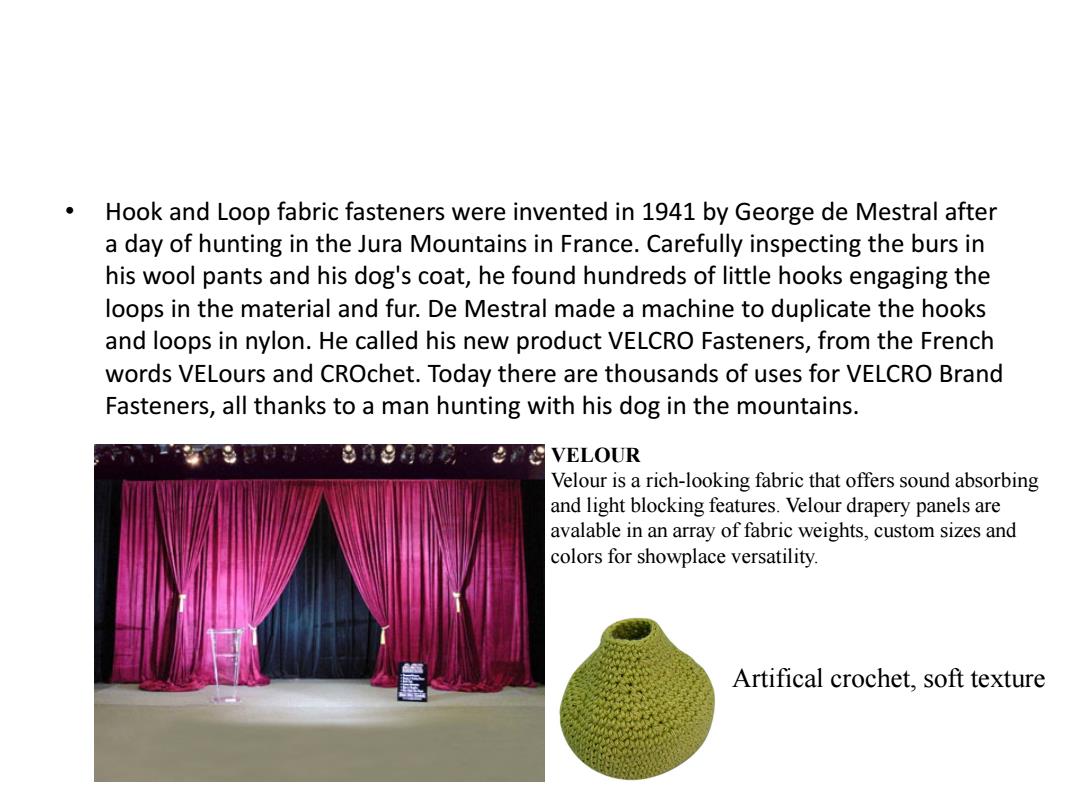
Hook and Loop fabric fasteners were invented in 1941 by George de Mestral after a day of hunting in the Jura Mountains in France.Carefully inspecting the burs in his wool pants and his dog's coat,he found hundreds of little hooks engaging the loops in the material and fur.De Mestral made a machine to duplicate the hooks and loops in nylon.He called his new product VELCRO Fasteners,from the French words VELours and CROchet.Today there are thousands of uses for VELCRO Brand Fasteners,all thanks to a man hunting with his dog in the mountains. 8 VELOUR Velour is a rich-looking fabric that offers sound absorbing and light blocking features.Velour drapery panels are avalable in an array of fabric weights,custom sizes and colors for showplace versatility. Artifical crochet,soft texture
• Hook and Loop fabric fasteners were invented in 1941 by George de Mestral after a day of hunting in the Jura Mountains in France. Carefully inspecting the burs in his wool pants and his dog's coat, he found hundreds of little hooks engaging the loops in the material and fur. De Mestral made a machine to duplicate the hooks and loops in nylon. He called his new product VELCRO Fasteners, from the French words VELours and CROchet. Today there are thousands of uses for VELCRO Brand Fasteners, all thanks to a man hunting with his dog in the mountains. VELOUR Velour is a rich-looking fabric that offers sound absorbing and light blocking features. Velour drapery panels are avalable in an array of fabric weights, custom sizes and colors for showplace versatility. Artifical crochet, soft texture

Factors leading to success 。Inquisitive Investigation/observation ●Insistence Learn from nature:Mother Nature is the best inventor Aid of tool (microscope)
Factors leading to success • Inquisitive • Investigation/observation • Insistence • Learn from nature: Mother Nature is the best inventor • Aid of tool (microscope)
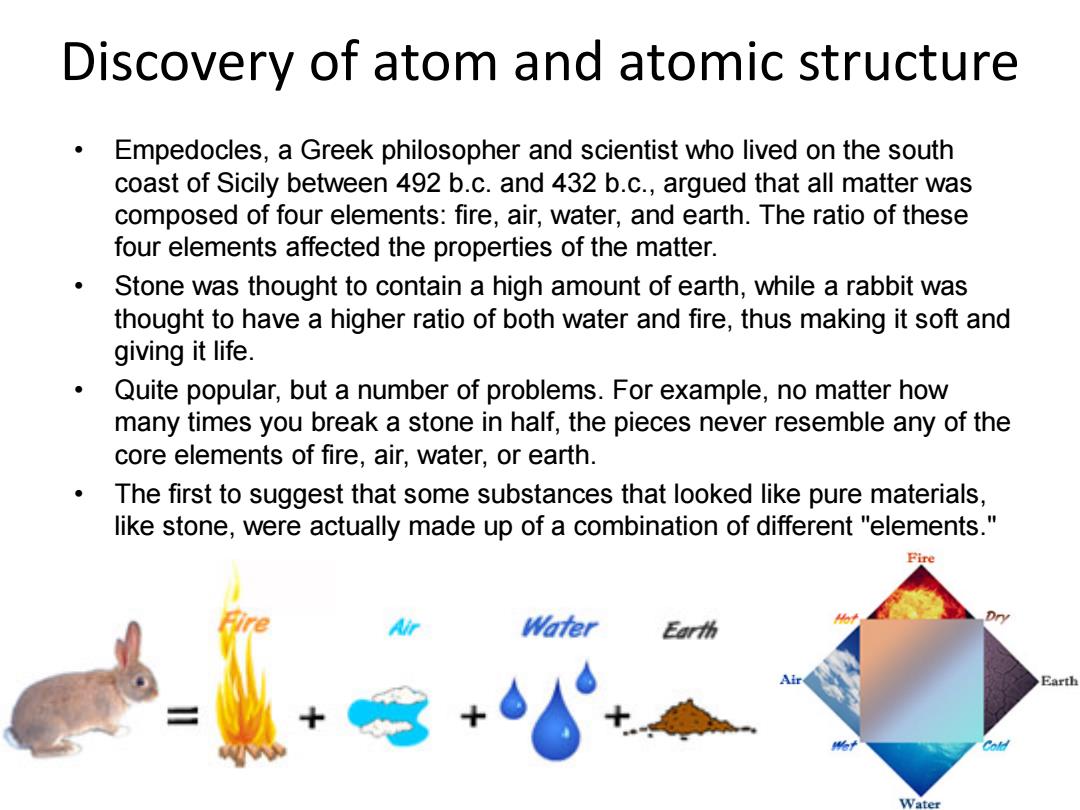
Discovery of atom and atomic structure Empedocles,a Greek philosopher and scientist who lived on the south coast of Sicily between 492 b.c.and 432 b.c.,argued that all matter was composed of four elements:fire,air,water,and earth.The ratio of these four elements affected the properties of the matter. Stone was thought to contain a high amount of earth,while a rabbit was thought to have a higher ratio of both water and fire,thus making it soft and giving it life. Quite popular,but a number of problems.For example,no matter how many times you break a stone in half,the pieces never resemble any of the core elements of fire,air,water,or earth. The first to suggest that some substances that looked like pure materials, like stone,were actually made up of a combination of different "elements." Fire Water Earth Earth
Discovery of atom and atomic structure • Empedocles, a Greek philosopher and scientist who lived on the south coast of Sicily between 492 b.c. and 432 b.c., argued that all matter was composed of four elements: fire, air, water, and earth. The ratio of these four elements affected the properties of the matter. • Stone was thought to contain a high amount of earth, while a rabbit was thought to have a higher ratio of both water and fire, thus making it soft and giving it life. • Quite popular, but a number of problems. For example, no matter how many times you break a stone in half, the pieces never resemble any of the core elements of fire, air, water, or earth. • The first to suggest that some substances that looked like pure materials, like stone, were actually made up of a combination of different "elements
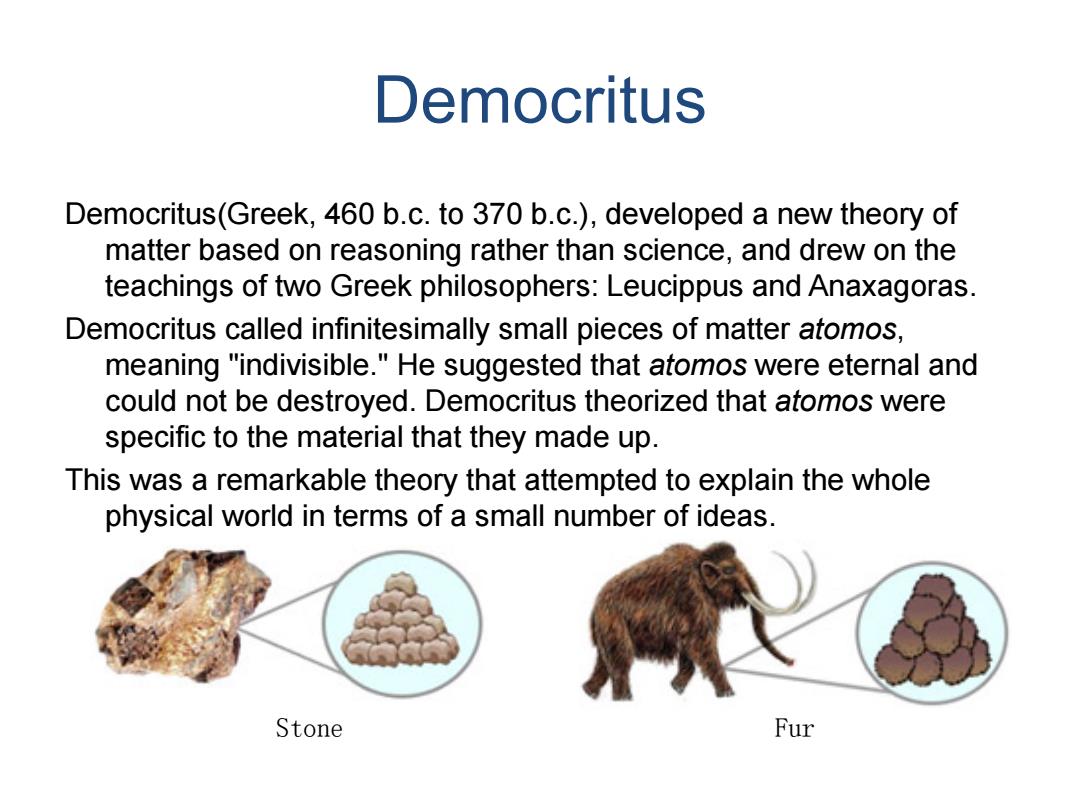
Democritus Democritus(Greek,460 b.c.to 370 b.c.),developed a new theory of matter based on reasoning rather than science,and drew on the teachings of two Greek philosophers:Leucippus and Anaxagoras. Democritus called infinitesimally small pieces of matter atomos, meaning "indivisible."He suggested that atomos were eternal and could not be destroyed.Democritus theorized that atomos were specific to the material that they made up. This was a remarkable theory that attempted to explain the whole physical world in terms of a small number of ideas. Stone Fur
Democritus Democritus(Greek, 460 b.c. to 370 b.c.), developed a new theory of matter based on reasoning rather than science, and drew on the teachings of two Greek philosophers: Leucippus and Anaxagoras. Democritus called infinitesimally small pieces of matter atomos, meaning "indivisible." He suggested that atomos were eternal and could not be destroyed. Democritus theorized that atomos were specific to the material that they made up. This was a remarkable theory that attempted to explain the whole physical world in terms of a small number of ideas. Stone Fur
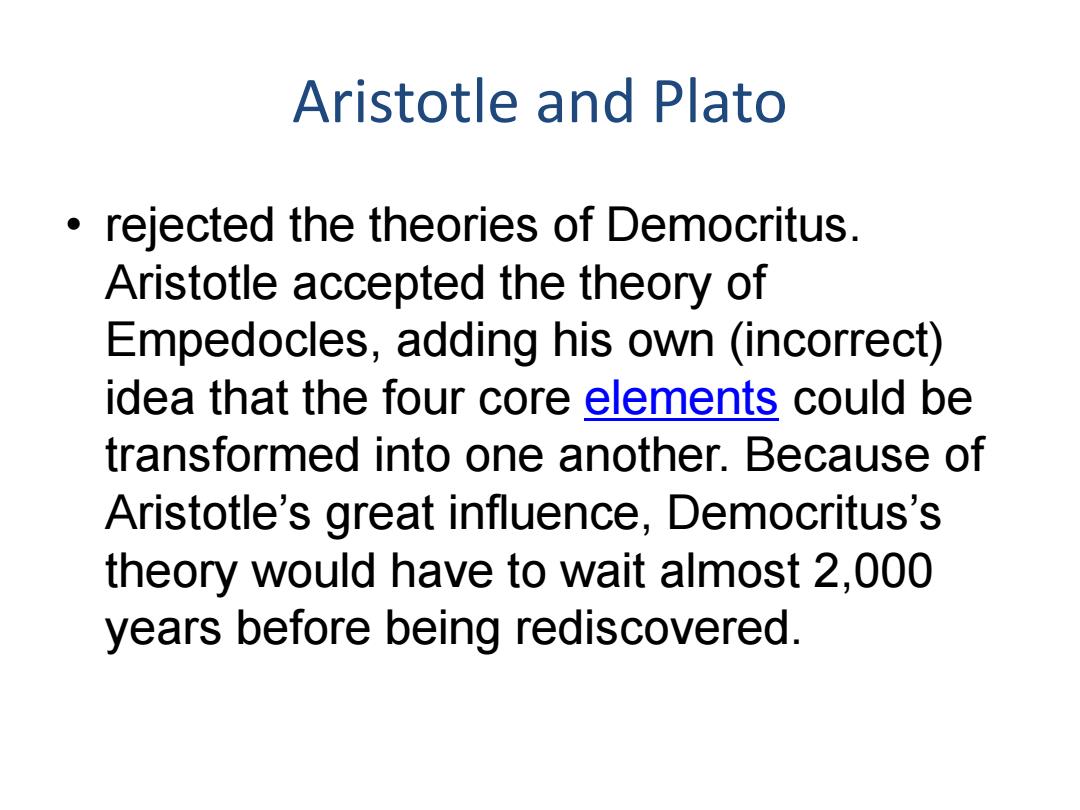
Aristotle and Plato rejected the theories of Democritus. Aristotle accepted the theory of Empedocles,adding his own (incorrect) idea that the four core elements could be transformed into one another.Because of Aristotle's great influence,Democritus's theory would have to wait almost 2,000 years before being rediscovered
Aristotle and Plato • rejected the theories of Democritus. Aristotle accepted the theory of Empedocles, adding his own (incorrect) idea that the four core elements could be transformed into one another. Because of Aristotle’s great influence, Democritus’s theory would have to wait almost 2,000 years before being rediscovered
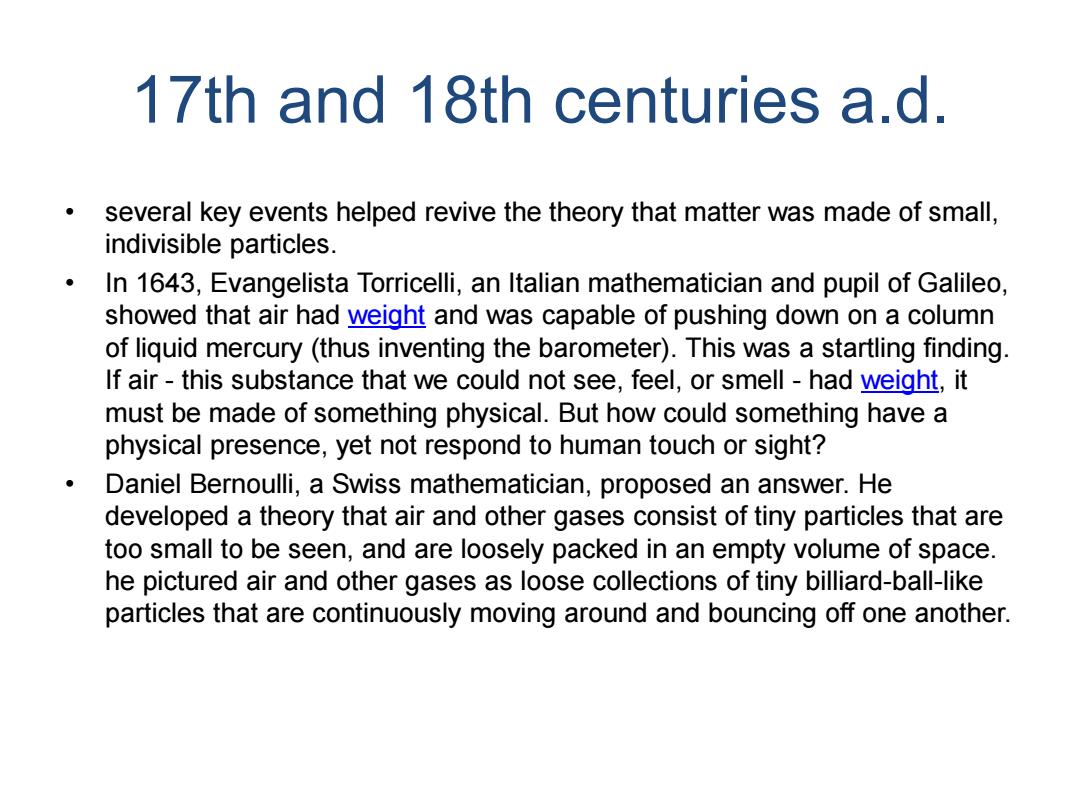
17th and 18th centuries a.d. several key events helped revive the theory that matter was made of small, indivisible particles. In 1643,Evangelista Torricelli,an Italian mathematician and pupil of Galileo, showed that air had weight and was capable of pushing down on a column of liquid mercury(thus inventing the barometer).This was a startling finding. If air-this substance that we could not see,feel,or smell-had weight,it must be made of something physical.But how could something have a physical presence,yet not respond to human touch or sight? Daniel Bernoulli,a Swiss mathematician,proposed an answer.He developed a theory that air and other gases consist of tiny particles that are too small to be seen,and are loosely packed in an empty volume of space. he pictured air and other gases as loose collections of tiny billiard-ball-like particles that are continuously moving around and bouncing off one another
17th and 18th centuries a.d. • several key events helped revive the theory that matter was made of small, indivisible particles. • In 1643, Evangelista Torricelli, an Italian mathematician and pupil of Galileo, showed that air had weight and was capable of pushing down on a column of liquid mercury (thus inventing the barometer). This was a startling finding. If air - this substance that we could not see, feel, or smell - had weight, it must be made of something physical. But how could something have a physical presence, yet not respond to human touch or sight? • Daniel Bernoulli, a Swiss mathematician, proposed an answer. He developed a theory that air and other gases consist of tiny particles that are too small to be seen, and are loosely packed in an empty volume of space. he pictured air and other gases as loose collections of tiny billiard-ball-like particles that are continuously moving around and bouncing off one another

Joseph Priestley,1773 Mercury calx actually breaks down into two substances when it is heated, liquid mercury and a strange gas. "what surprised me more than I can well express was that a candle burned in this air with a remarkably vigorous flame.a mouse placed in a sealed container of this gas lived for a longer period of time than a mouse placed in a sealed container of ordinary air. Priestley's discovery revealed that substances could combine together or break apart to form new substances with different properties.For example, a colorless,odorless gas could combine with mercury,a silver metal,to form mercury calx,a red mineral Priestley called the gas he discovered dephlogisticated air would not stick. Mercury calx
Joseph Priestley,1773 • Mercury calx actually breaks down into two substances when it is heated, liquid mercury and a strange gas. • “what surprised me more than I can well express was that a candle burned in this air with a remarkably vigorous flame.” a mouse placed in a sealed container of this gas lived for a longer period of time than a mouse placed in a sealed container of ordinary air. • Priestley’s discovery revealed that substances could combine together or break apart to form new substances with different properties. For example, a colorless, odorless gas could combine with mercury, a silver metal, to form mercury calx, a red mineral • Priestley called the gas he discovered dephlogisticated air, but this name would not stick